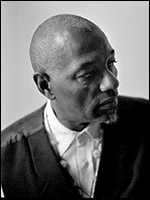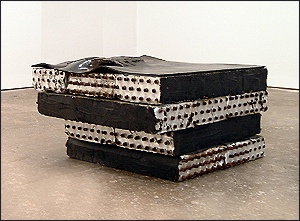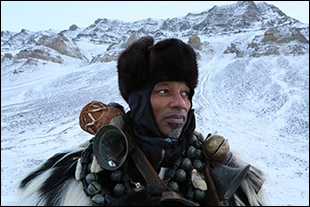Terry Adkins

Terry Adkins is an installation artist, musician, activist, and cultural practitioner who for 20 years has pursued an ongoing quest to reinsert historically transformative figures to their rightful place in the landscape of regional and world history. Although his "recitals" combine sculpturally based installations with music, video, literature, and ritual actions that intend to uphold and preserve the legacies of his chosen subjects, Adkins's work is always abstract and lyrical. An inspiration to younger artists for his uncompromising stance, he is also a dedicated teacher as Professor of Fine Arts at the University of Pennsylvania.
Originally posted February, 2006
Terry Adkins is a REVOLUTIONARY.
In a time and a place where courage seems to be waiting in the wings, Terry Adkins is front and center about what he thinks. About who he is and what he stands for -
Terry Adkins offers no apologies.
DR: Tell me. Terry, whatever it is that you want me to know about your life.
TA: O.K. Gee.
I grew up kind of gifted, with the ability to be able to render things like a photograph. So I was moderately inspired or encouraged by my parents in funny ways. For instance, for Christmas, my younger brother might get a Tonka truck, but I would get Leonardo DaVinci's Last Supper to paint by number. I can remember my mother saying "Don't mess it up! This cost me a lot of money!"
I never really considered a career as an artist. Often times when you are gifted with something you tend to be the first one to take it for granted because you don't think there is any thing wondrous about it. All of your friends, who are gifted with other things, might be able to recognize your gift easier than you can. I never really took it seriously until I went to college. I went to Fisk University and saw an exhibition there by John Scott who is an artist that is still active in New Orleans, and it turned me around. From then on I decided to be a visual artist. I had always been a musician before that.
My quest has been to find a way to make music as physical as sculpture might be, and sculpture as ethereal as music is. It's kind of challenging to make both of those pursuits do what they are normally not able to do. That has been my challenge.
Another aspect of how I work is that I use figures in history whose contributions to society are either under known, under appreciated or just not given the stature that I believe they should have in society. In the past I'd do these events called recitals where I would do a body of abstract works that relate to the topic at hand. In the past they have been Sojourner Truth, John Brown, Zora Neale Hurston, John Coltrane, Ralph Ellison and W.E.B. Dubois, and others whose world view I find similar to my own.
My quest is to use abstract means, to educate the public about these figures through ways that are not image based or narrative based but to challenge them to think abstractly in relating to the stories of the lives of the people concerned.
TERRY ADKINS RECITAL
Terry Adkins Recital from The Tang Museum on Vimeo.
Recital brings together a selection of work from the past 30 years by artist and musician Terry Adkins. Combining sculpture and live performance, Adkins has described his approach to art-making as being similar to that of a composer. His sculptures re-purpose and combine a range of materials, such as fiberglass propellers, wooden coat hangers, parachute fabric, and a variety of musical instruments in a process that the artist calls "potential disclosure," which aims to reveal the dormant life in inanimate objects.
During performances with members of his Lone Wolf Recital Corps, Adkins activates these objects through improvisational playing and singing, spoken word, costumes, and recorded sound. These events intend to uphold the legacies of immortal and enigmatic figures such as Bessie Smith, John Brown, Sam Lightnin' Hopkins, Matthew Henson, and John Coltrane, among others. Adkins not only resuscitates individuals from historical erasure, but also sheds light on willfully neglected or ignored aspects in the lives of well-known figures, such as Ludwig van Beethoven's possible Moorish ancestry or Jimi Hendrix's military service as a paratrooper in the 101st Airborne.
Terry Adkins Recital is curated by Ian Berry, Dayton Director of The Frances Young Tang Teaching Museum and Art Gallery at Skidmore College, in collaboration with the artist.
DR: Terry is there something, when you think about your work or your life for that matter, is there something that stands out that you are really proud of?
TA: Well, I am most proud of my...what I have partnered in...to be my greatest creation, my son, OUR son, Titus and OUR daughter Turyia. They stand out because...
Well, in the instant a child is born you adapt a vision beyond your own lifetime and it brings things really into focus in your life. I find that, in the United States, there is very little vision beyond ones own lifetime. If there were then teachers would be the highest paid workers in society, as they are the caretakers of the future of the country. As it is in Korea and in other places where teachers are the highest paid. But in the United States, there is so much preoccupation with wealth being equated to success, and the billionaire is the hero of modern life and it is all backward to me.
What I try to do is instill in my kids, so that they'll carry on the baton to make the world a better place -- that theses materialistic things really don't matter. It's what you carry within your soul that matters.
DR: How do measure success then, Terry - personally.
TA: Personally I measure success by being able to express myself freely, being able to exercise my creative imagination freely and if I am able to do that without any kind of hindrance and to, every once in a while, make some money from it, although that's not really ideal, I measure that as a form as success. Also because I am a college professor at U Penn, I measure success by how well my students are then equipped with what I give them; how they then surpass me in their careers - which a couple of them already have.
DR: When people look at you, what do you hope that they see?
TA: Well, first of all, I know this is idealistic, but I would hope that the first thing...that they would not, at first, "race my face"; that they would be able to look past that to see a little deeper and to uh...
DR: Did you say "race my face"?
TA: Yeah. "Race my face". In other words Ornette Coleman has a saying in one of his songs that says "don't race my face to class my ways". Living in America...that would be a great achievement - to have that occur. Although I feel that particularly in New York City, or in many other urban centers, that it rarely does because of the negative images projected of Black men and the fear generated in cities by the images they see in the media.
If a person would be able to look at me to see past that, then we could then begin to relate to each other as human beings. The big question to day is "What does it mean to be human" and "How does that play out in relationship to what W.E.B. Dubois said" which is "The problem of the 20th Century is the problem of the color line.", which is so prophetic a statement as evidenced today in just about -
everywhere.

Smoke Stack 2003
copper, aluminum, tar, 16.5 x 30 x 30 inches
DR: So if people were to look past your race, if they didn't "race your face", as you say, what would they see Terry?
TA: I have no idea. It's in the eye of the beholder and I think that they would see what they bring to it. I, however, am steadfastly -
myself.
I guess for any number of individuals, they would see any number of different things. What -- I would not begin to try and suggest. If they could get past the "face racing", that would be an achievement in and of itself.
DR: What do you think is most inspiring about you?
TA: I was born into a segregated America so, as a torch bearer of the way things were during that period, I guess, I would hope that people find it inspiring that there is a sense of self achieved from witnessing segregation wherein there were all sorts of Black businesses and entrepreneurship all around.
Having been educated at an all White, all boys, Catholic school called Ascension Academy, where I went on an on an academic scholarship from the 5th grade to the twelfth grade...it allowed me to acquire a sense of myself that didn't even deal with the idea of being inferior, but also didn't deal with the idea of being superior either. It made me, very early on, able to see that it was. Dr. King would say in "the content of one's character" that one should be judged - well not judged because you could say "Judge not, lest thou be judged", but the "content of ones character" is what matters most.
I got to see that the richest kids were also the dumbest. I got to see the social strata that exists in society, disappear because in the classroom everyone was equal. It really mattered how smart you were, more than anything else.
Very early on, I didn't really have any sense of any inferiority complex or anything like that. I think the sense of self and security in knowing oneself, I would think would be the most inspiring thing about me.
DR: What do you think that you have contributed to the world so far?
Terry Adkins, Composer of Art, Sculptor of Music, Dies at 60
by Margalit Fox for The New York Times
Feb 22, 2014
photo credit: Tom SnelgroveTerry Adkins, a conceptual artist whose work married the quicksilver evanescence of music to the solid permanence of sculpture, died on Feb. 8 at his home in Brooklyn. He was 60.
The cause was heart failure, his dealer Jeanne Greenberg Rohatyn said.
A sculptor and saxophonist, Mr. Adkins was at his death a professor of fine arts at the University of Pennsylvania School of Design. His genre-blurring pieces, which might combine visual art, spoken-word performance, video and live music in a single installation, had lately made him "a newly minted breakaway star" on the international art scene, as The New York Times described him in December.
Mr. Adkins's work - cerebral yet viscerally evocative, unabashedly Modernist yet demonstrably rooted in African traditions - has been exhibited at museums and galleries worldwide, including the Whitney Museum of American Art in New York.
TA: I have tried to contribute to the creative area of Black art in America in a way that does not cow tow to a certain kind of "minstralry" - that's what I call it.
I think that the majority of Black art that you see in America is image oriented for a very particular reason. It relates back to this idea of "Brand Black" entertainment. America has never had a problem being entertained by Blacks in this country but always a problem being challenged by us. One of the troches of bringing back entertainment are - there are two of them. One is that it must first be posited in an image...like a cartoon. And the second is that it try to explain the "being in the world of Blackness" to a White Art audience - through image. To me, it creates a situation wherein the Black art that you see today, 98% of it, which is image oriented, is not too far removed from the images that you see on Uncle Ben's converted rice and Aunt Jemima's pancakes that you now see in the grocery store. It is entertainment oriented toward an audience. I call it a very conciliatory Louis Armstrong-how-are-you-ism, that attempts to explain the "being in the world of Blackness" to a White audience. I am from the school of the Miles Davis-how-dare-you-ism, that deals with the principles of what Afro-Atlantic culture is, not through the appearance of it in images, but through the principles that guide it that are very high order abstract thinking. This is evidenced by anybody that takes a look at African sculpture and the societal norms that created a society in which abstraction was primarily their means of expression.
If you look today you will see mostly image oriented stuff which I think is a crisis.
So, my contribution to the world, finally getting back to your question, is that I have maintained this connection, to genu gap a generation of African American artists who work entirely abstractly and, I keep that flame burning.
DR: I am inspired by that and I have never really thought about, or stopped to consider what you just shared, as it pertains to art.

Particular Zither 1990
7 x 108
TA: Well it's true of art. I think it's true of the athletic arena. I think it's true of song and dance. I think it's true, to a certain extent, to the movie industry. I mean Big Momma 2 is coming out. I mean c'mon! You know what I mean! Those kind of images, which I think Spike Lee really addressed in his Bamboozled film, are the result of a long history of Black entertainment in America, which has never ever been a problem. That's why Ben Vareen could do an Al Jolson thing at Nixon's inauguration.
Never a problem with entertainment -- Always a problem with being challenged.
And for the challenging side, you can see how people like Paul Robeson and W.E.B. Dubois were treated in this country.
The intellectual vanguard of Black America has always had a rough time because they didn't succumb to the entertainment value and the image thereof. The intelligencia has always, to a certain degree, been persecuted, particularly those who show a vision beyond; a world vision, that is beyond the fifty states of America.
DR: I think that these are not only interesting points that you bring up, but I think particularly relevant on a day like today when people are thinking about race on the heels of the death of Coretta Scott King and the contribution that she made. Those kinds of things have people contemplating the issue of race. What you are talking about is a layer that rarely gets addressed.
TA: Well, I think that you are right about the death of Coretta Scott King, rest in peace. The recent death of Rosa Parks, too, also focused it. The re-opening of the case of Emmit Till, his body being exhumed - all of these things have brought back the ghost of the Old South, right back into contemporary society.
DR: What I want to know Terry is, when you think about disappointment, is there something that disappoints you about yourself and how do you reconcile it, or live with it?
TA: Oh I often find disappointments. Sometimes I think I'm not being the best husband or father in the world, particularly when...
You know as well as I do that there is no text book on parenthood. There is no right way to do it. Every child that you come across will make you change the notes that you have already taken.
I have disappointments when I feel that in some way I have made improper judgments as far as they are concerned and may have wounded them in ways that I may never know. That's what I get disappointed by.
Sometimes you get disappointed - if I feel that I begin to get down on myself about sticking to my guns and how that might have compromised my career -- in sticking to my guns about this abstract thing.
So, sometimes I get a little disappointed maybe thinking that maybe, had I thrown in the towel and succumbed to it, I could have been more economically successful. But in the end I guess it's really not a disappointment because I feel more noble not taking part in it.
DR: And so is that part of how you reconcile it for yourself?
TA: Yes. That indeed is the reconciliation.
I think about the commercial aspect of it only in terms of how it might have benefited my family. So I get disappointed sometimes when I can't sell work and can't contribute financially through my creative efforts. But teaching takes a lot of the edge off that.
DR: Tell me -
A hundred years from now, what do you want to be remembered for?
TA: I want to be remembered as a creative individual, who in spite of the tide of the horizontal breadth of image ridden work by Black American artists, stood for something else; stood for something different.
I hope that a hundred years from now some little boy or girl somewhere, will see something that I have done, and pick up the baton and go on to continue the tradition.
Thanks Terry!

